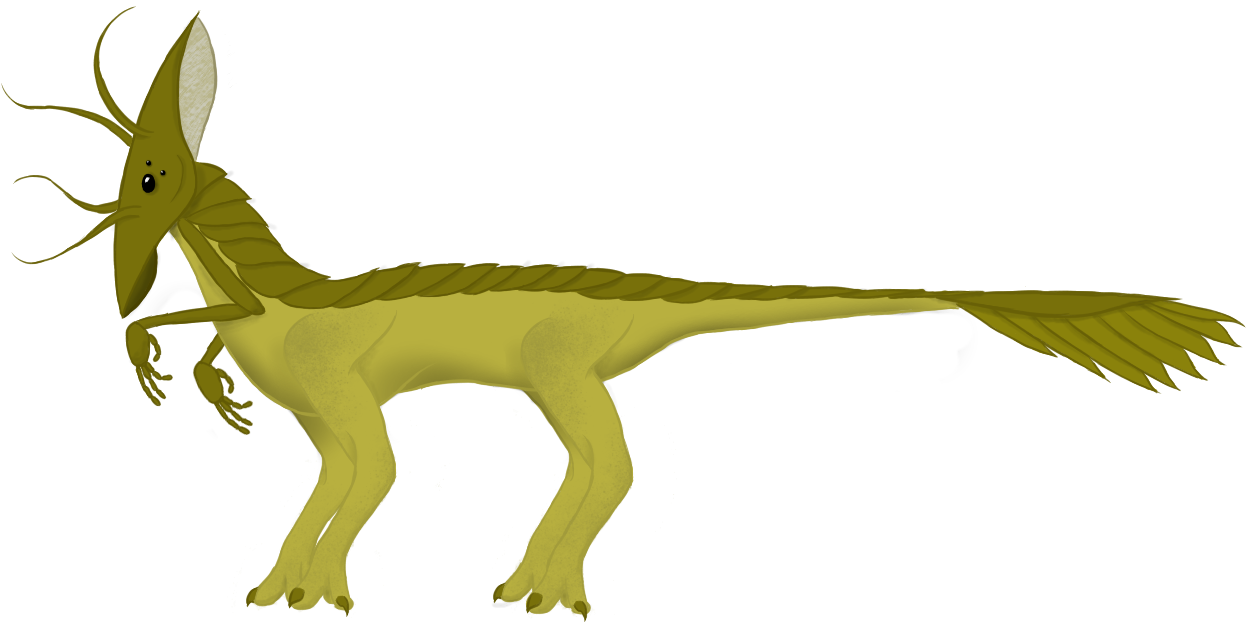Skae
Biology
Anatomy & Morphology
Skae are quadrupedal hexapods with a centauroid body plan, having a four-footed stance supported by both sets of endoskeletal legs while the foremost exoskeletal pair of limbs serve as their primary manipulators. The rear section of the spinal column transitions into a long, rather stiff tail used as a balance mechanism. The skae skeletal system is composed mostly of titanium-supplemented chitin, and is very complex due to their nature as placospondyls: a unique phylum of the Ranagenid group that are defined as having an exoskeletal spinal column, skull, and first set of forelimbs, while the rest of the body -including the other two sets of legs- are endoskeletal. The exoskeletal sections are typically covered by a very thin layer of soft tissue, which has developed into two pairs of gracile, dexterous tendrils on the skull. Skae respiration is facilitated by a pair of almost gill-like slits on either side of the neck, just behind the skull. These spiracles are independently controlled and are quite articulate, forming the basis of the dual-layered speech characteristic of skae. Actual cellular respiration is orchestrated by a cardiovascular system not unlike that of terragenid animals, though the skae's vascular oxygen carrier is hemovanadin, a vanadium-based protein that turns vivid green when oxidized.
Perception & Sensory Capabilities
Visual
Skae have a total of six superfine-lensed compound eyes. The primary pair are the largest and most sensitive to detail, able to detect well into the infrared; the two sets of secondary eyes are far smaller, simpler ocelli attuned to motion and shades.Auditory
Skae are incredibly sensitive to aural stimuli thanks to their large head crests. The crests are composed of densely-packed tympanic setae that form a pair of pseudo-membranes which extend from both sides of the actual skull. Distantly evolved from gills, the sensory crests also serve as the primary olfactory organs.Olfactory
As mentioned above, the tympanic head crest at the top of the skae skull also serves an olfactory function. This is supplemented by the four tentacular antennae appendages that emerge from the skull in pairs above and below the eyes.Tactile
In addition to supplementing the olfactory sense, the facial tendrils of skae are also highly sensitive tactile sensors, akin to independently-mobile whiskers.Ecology
Geographic Origin & Distribution
Skae are somewhat uncommon outside of their home system of Tau Ceti and the handful of other systems they inhabit exclusively. However, there are appreciable populations of them on warmer worlds across known space, particularly in the nearby stars of Cetus and adjacent constellations.Habitat & Survival Factors
The optimal survival range in a variety of factors for an unequipped skae is reasonably wide, though given the technology and/or resources to build said technology, said range expands considerably. Skae are more comfortable in warmer environments than in colder ones, though they can adapt to cold temperatures fairly easily. Their primary limitation is oxygen concentration; at 1 bar, the lowest breathable O2 percentage for a skae is 28%.Sociology
Language
Skae speak a wide variety of languages, almost all of which are fundamentally unpronounceable to humans due to their layered nature. Skae speech is based on stacked sounds, facilitated by their twin breathing spiracles situated directly behind the eyes. Shem/kal, for example, is representative of the sounds "shem" and "kal" being pronounced simultaneously, one half by the right spiracle and the other by the left. The most generally accepted way of transcribing skae language into a format pronounceable by the other USSC species is to pronounce the "upper" half of the word first, separated by an apostrophe from the "lower" half (e.g. Ra/na becomes "Ra'na.")Archive Data
- visual (320 - 720 nm)
- auditory (20 Hz - 30 kHz)
- tactile (2 μm limit)
- olfactory
- Gamma: 0.3 Gy
- Beta: 0.1 Gy
- Alpha: 0.05 Gy




Comments